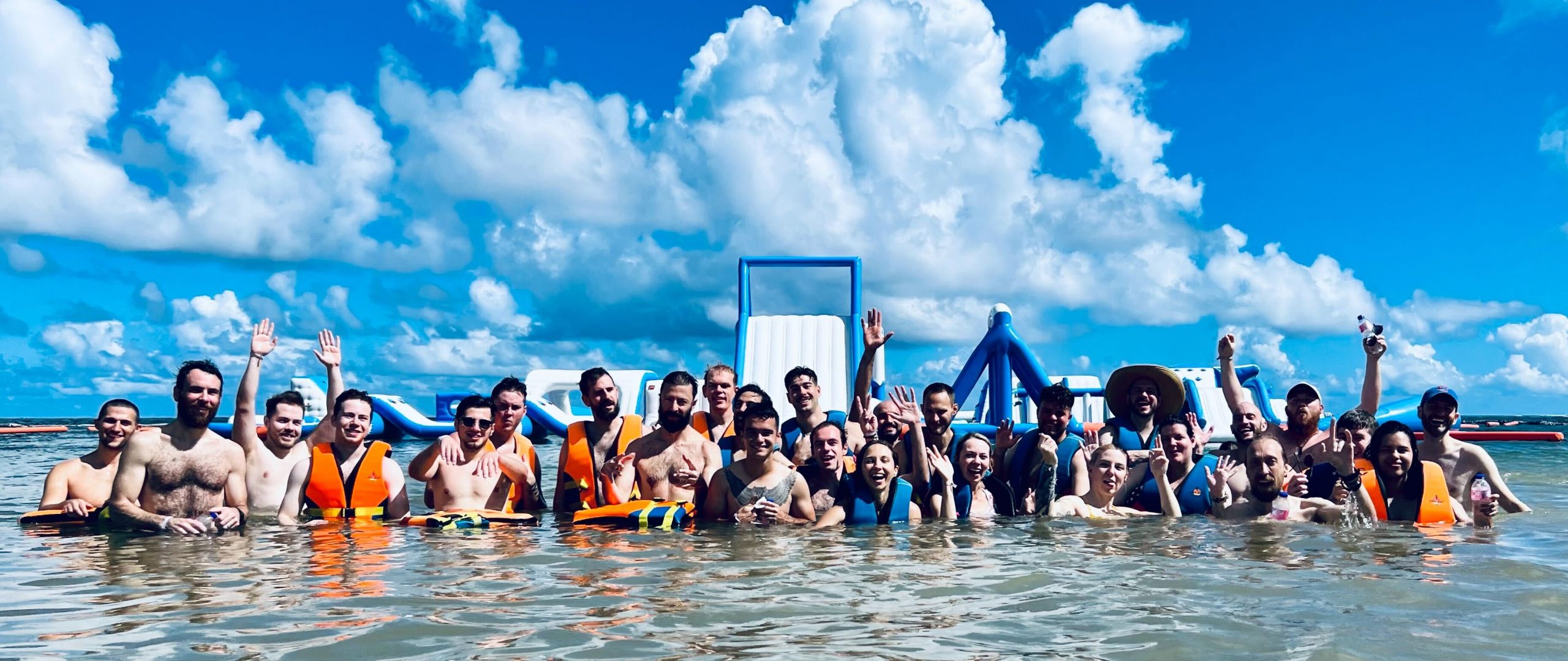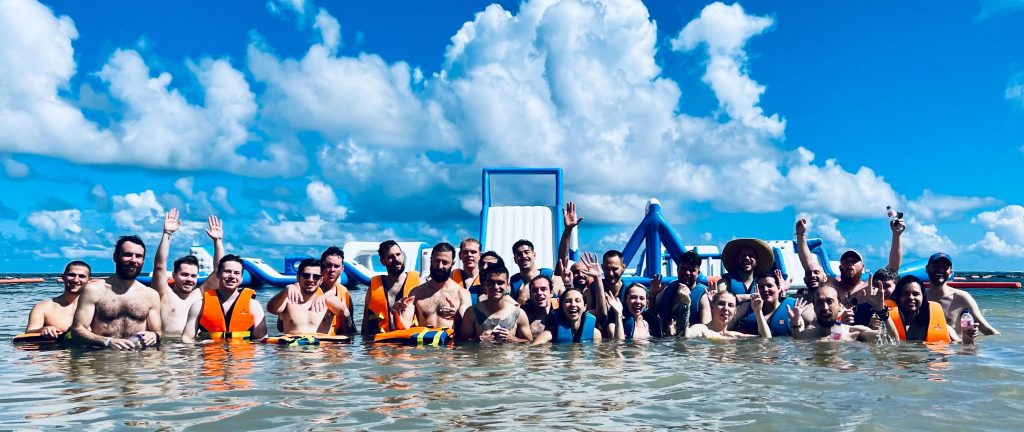Effective Team Retreat Planning Guide In 6 Steps

In this article
Working for a startup these days is pretty stressful. Layoffs are taking place left and right, VC funding has come to a screeching halt, and everyone is being asked to accomplish more with less time or resources.
While it may be tempting to cut team retreats or offsites from your budget altogether, what’s the alternative? In a remote and hybrid work environment, your colleagues are not seeing one another day-to-day and can easily become overwhelmed, disengaged, or removed altogether from your company, spending half their days looking for other jobs.
Even if you don’t race supercars or charter yachts in Miami, planning regularly occurring, high ROI, and cost-effective team retreats is one of the most important things you can do to keep your team energized, achieve greater alignment, and build a culture of peak performance.
Thanks to SwagUp, I’m here to share an Effective Team Retreat Planning Guide In 6 Steps. As the co-founder/CEO of Offsite, a company that makes team retreat planning stress-free for hundreds of VC-backed startups, Inc 5000s, publicly-traded companies, and others, I’m hoping these pro-tips can convince you that planning team retreats should remain a high priority, especially if you manage a remote or hybrid team.
1 . Consider The Objectives For Your Offsite Before You Begin Planning
The first step to planning your next corporate retreat, start with your objective. It’s easy to get caught up in looking at flashy photos of hotels, dreaming up tropical destinations for you and your team, or (worse) drowning in details for what it takes to pull off a memorable team retreat. Like running a business, it pays to “start with the end in mind” and consider what success looks like for a team retreat.
Are you planning the offsite to engage and retain top talent? Or are you looking to incorporate strategic planning sessions, such as OKRs for the upcoming quarter, and seeking alignment? Are you looking to provide your team with a transformational experience with personal and professional development sessions? Are you looking to celebrate, relax, or motivate?
However you decide your objectives, I’d recommend limiting the high-level decision-making to only a couple of decision-makers, such as executives or team leaders.
What you determine as your objectives for the team retreat will dictate the time of year you meet (for example, a sales kickoff is likely to occur at the beginning of your fiscal year, while an executive team retreat centered around strategic planning may occur at the end of each quarter to plan for the next). Your objectives will also determine where you bring your team, how you structure your agenda, and more.
2. Plan Your Budget in Advance
There is a wide range of expenses to consider as you begin to plan your corporate retreat. You don’t want to be surprised by fees, last-minute additions, travel costs, etc. And so, budgeting at the beginning of your team retreat planning efforts will save some headaches later on.
Some of the top-line items to consider are:
- Airfare
- Hotel room blocks (including room nights, tax, resort fees, and parking)
- Meeting space (including A/V, food and beverage minimums, and tax)
- Meals at your venue, as well as out-on-the-town and consumed during travel
- Uber, Lyft, or shuttle service to and from your venue(s) from the airport
- Uber, Lyft, or shuttle service to and from your venue(s) to team activities
- Any activities you plan for your team
- Keynote speakers and/or outside facilitators
- Photographers and/or videographers
- Swag, of course!
One of the most expensive and consequential decisions will be your hotel, as you’ll likely spend most of your budget there between rooms, meals, meeting space, and more. Hotel contracts can get confusing, so at Offsite we’ve put together a guide to understanding terms on a hotel room block contract so you can ensure you’re educated and protected.
You can use Brex or Ramp to issue temporary credit cards with limits to your team so they can book their own airfare and cover incidentals while traveling, and work to negotiate with hotels and meeting space providers in order to save. In all, you’ll likely spend $1,000 to $2,500 per person, per Offsite (unless you are really looking to ball out for a President’s Club event, executive team retreat, or Board Meeting, where it might get to $3,000+ per person).
3. Send Feedback Forms To Your Team Before and After Offsites
While you don’t want to have “culture committees” of 10+ people chiming in with their ideas, slowing down the decision-making process at every turn, once you decide on high-level objectives for your offsite, you do want to send a pre-offsite feedback form to your team, asking them very specific questions to engage them months before your team retreat takes place.
This is a great opportunity to cover the basics of dietary preferences, any travel sensitivities your team may have, and expectations your team may have for the upcoming offsite. You can also ask more specific questions about what type of activities your team might want to experience, what their hopes are in terms of career development, what ideas they have that can improve the agenda, and how you (as a manager or team leader) might be able to improve their work lives on a day-to-day basis even before the team retreat takes place. Finally, you might want to poll the team for employee engagement metrics like an employer net promoter score before the offsite and after to see if regularly-occurring team retreats are making a measurable difference in employee engagement, satisfaction, and alignment.
4. Be Intentional In How You Plan Your Agendas
Every team retreat will have a different agenda, but some of the building blocks are the same for all effective offsites.
For one, you have to factor in enough time for your team to travel in for the team retreat and travel back home. That means the first day of your retreat should be lighter on programming, and it is recommended you provide your team ample time to recover from potentially stressful travel, acclimate to the new environment, and transition from their daily lives into the new experience of your retreat.
The first night, host a welcome dinner and activity and keep programming light and fun.
For the remainder of your time together, give your attendees a mix of team-building (through icebreakers, workshops with an outside facilitator, and activities that lead to deep, meaningful connections via unique shared experiences), skill-building (through keynote speakers or presentations from your team to one another to share what each other is working on), strategic planning, and fun.
Don’t forget to add lots of “flex time” to your agenda in case you run over, and to give your team time to call home, workout, take a nap, and stay energized through what might be an intense and emotionally draining time for those who aren’t used to being around lots of people.
5. “Who” Does “What” By “When”
Hopefully, if you are intentional about how you’d like to use your team’s time at an offsite, you’ll walk away with breakthrough ideas, action items, and notes that you’d like to use post-retreat.
However, many teams forget to implement a system by which great ideas, notes, and conversations become action.
We recommend assigning someone company-wide to be the “scribe” during important sessions, or multiple scribes if there are breakout groups, to ensure notes are recorded during brainstorming and problem-solving exercises.
It is also recommended notes be recorded digitally for easy conversion to your project management system, be it Asana, Notion, or elsewhere. Further, for action items, you may follow the practice of noting “who” (person on your team) needs to do “what” (action item) by “when” (due date).
The ROI from your team retreats truly happens in follow-up, so don’t forget this important step!
6. Leverage Your Offsites For “Employer Marketing”
We recommend hiring a photographer and/or videographer for some or all of your team retreats in order to capture content. You can show the world how awesome your company is by sharing it on your website or social.
Additionally, these offsites should lead to peak experiences for your team. You can ask your employees in the weeks following to leave reviews on GlassDoor or other employment websites. This further helps to increase your ability to hire and retain more great people in the future.
Investing in swag for your team is a great way of engaging employees who currently work for you. When your team wears their branded swag their friends may inquire about working at your company, too.
If it’s also apparent you host regular team retreats for your employees, it will be all the more enticing for friends of your team to inquire about job openings at your company, and you’ll be able to find talent with ease.
While employer marketing shouldn’t be the main reason you host an offsite, it is added ROI that you shouldn’t forget about when planning an effective team retreat.
7. Stress-Free Team Retreats
Our team at Offsite works tirelessly to help remote and hybrid teams like yours plan more frequent and memorable in-person experiences because we know how important team retreats are for building great company culture and combating the loneliness we may feel working from home without constant interaction with our colleagues.
👀 Check out some Offsite Team Retreats


We’re proud to partner with SwagUp for clients of ours who want to invest in swag as part of planning more effective offsites, and if you’re interested in learning more about how we help companies save time, money, and stress when planning offsites, please visit www.offsite.com.
👀 Looking for more ways to engage your teams? Download our Employee Engagement Calendar Here!


.png)
.jpeg)


